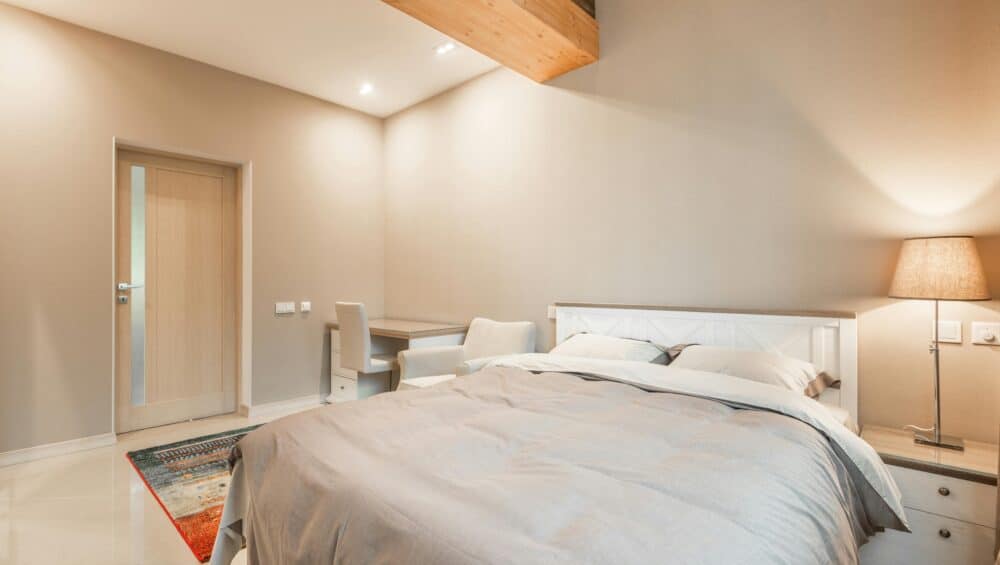Bedroom design affects sleep quality. Research shows visual clutter increases cortisol levels. This stress hormone disrupts rest cycles. Wall treatments influence how quickly people fall asleep and how deeply they rest. Ideas for wall decor in bedroom settings must prioritize calm while expressing personality. The most effective designs work subconsciously. They create comfort without demanding attention. Modern approaches reject the notion that bedrooms need abundant decoration. Strategic choices outperform quantity every time.
Scale Transforms Ordinary Rooms
Oversized art commands attention immediately. Single large pieces create drama without complexity. Ideas for wall decor above bed benefit from bold scale choices. A six-foot canvas eliminates the need for additional elements. Murals covering entire walls transport occupants to different environments. Forest scenes bring nature indoors. Abstract patterns add movement without representation. Removable wall decals offer scale without permanence. They give renters decorating freedom. Homeowners can use them to experiment without commitment.
Framed Photography Tells Personal Stories
Photographs hung on walls create intimate connections to memories and experiences. Travel photos from meaningful trips bring adventure into daily routines. Family portraits establish emotional anchors in private spaces. Frame selection affects the overall presentation. Using wood frames adds warmth. Metal frames provide sleek edges for contemporary styles. Mat boards create breathing room around images. The extra space prevents cramped appearances. Proper sizing matters. Large prints make bold statements above beds, and adding framed wall accents further enhances the visual impact. Smaller collections work well along narrower wall sections near closets or windows.
Fabric Installations Soften Hard Surfaces
Upholstered wall panels absorb sound. This quality matters in urban apartments with thin walls. Fabric choices range from velvet to linen. Each material creates different moods. Tapestries hung from decorative rods add medieval romance. Mounting quilts as art celebrates craftsmanship. Tension rods allow seasonal fabric rotation. Summer linens swap for winter wools. The practice keeps rooms feeling fresh without purchasing new items.
Botanical Elements Bring Life to Interiors
Wall-planters introduce living greenery without consuming floor space. Mounted pots hold trailing plants like pothos and string of pearls. The cascading foliage adds organic movement. Pressed botanical prints offer plant aesthetics without maintenance requirements. Framed ferns and leaves provide scientific illustration appeal. Adding multiple small plants to walls creates dramatic vertical gardens. The installations require proper irrigation systems. Artificial plants offer low-maintenance alternatives. They provide similar visual benefits. Green tones promote relaxation according to environmental psychology research. The natural elements connect indoor spaces with outdoor environments. They are one of the best ideas for wall decor in living room spaces and bedrooms.
Sculptural Objects Create Focal Points
Three-dimensional wall sculptures add artistic sophistication. Metal wall art in abstract forms provides a modern edge. Ceramic pieces in organic shapes are another good addition. Wood carvings showcase artistry. The depth creates plays of light and shadow throughout daily cycles. Sculptural letters spelling meaningful words personalize spaces. Massive initials work well in children’s bedrooms and adult spaces alike. The dimensional quality prevents flat, lifeless wall surfaces. Strategic placement is key. Sculptures work best with ample surrounding space. Crowded arrangements diminish individual impacts.
Intentional Emptiness Serves Purpose
Blank walls provide visual rest. Overstimulation prevents quality sleep. Leaving one wall completely bare focuses attention on the remaining decorated surfaces. This contrast makes chosen pieces more impactful. Minimalist approaches reduce cleaning demands. Fewer items mean less dusting. The practice also accommodates future additions without requiring removals. Bedrooms function as personal retreats. Decoration should enhance this purpose rather than contradict it.

